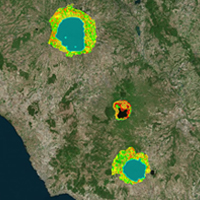Interactivity of WebGIS for the Simulation of Land Development
DOI:
https://doi.org/10.6092/1970-9870/2885Keywords:
GIS, WebGIS, Simulation, Land Use Planning.Abstract
In the definition of scenarios as key components underlying the decisions on city’s and territory’s transformation processes stands the comprehension of the interactions between multiple aspects that influence that dynamics. The spatial data knowledge and the development of new ICT solutions which can guide the planner towards strategic, reliable and shared decisions are essential. It is proposed a methodology in which to specialize the special approach established in previous projects developed by extending and implementing GIS technology Geographic Information System towards online interoperability. The control of the effects of changes in land use in environmental quality, particularly in the water resources management, can thus become operational in the network through the application of innovative tools able to meet the new challenges of urban regeneration.
Downloads
References
Ippolito, A.M. (Ed.). (2012). Il progetto di paesaggio come strumento di ricomposizione dei conflitti. Milano, IT: Franco Angeli Editore. ISBN: 9788820409548.
Caiaffa, E. (2006). Sistemi informativi geografici. Roma, IT: Enea Ente per le Nuove tecnologie l’Energia e l’Ambiente. ISBN: 88-8286-140-6.
Di Giacomo, T.V. (2014). Volcanic lake basins integrated framework for landscape functionality. In C. Biscarini, A. Pierleoni, & L. Naselli Flores (Eds.), Lakes: The mirrors of the Earth. Balancing ecosystem integrity and human wellbeing. Volume 2: Proceedings of the 15th World Lake Conference (pp 264-267). Napoli, IT: Science4Press. ISBN: 978-88-96504-04-8 (print), ISBN: 978-88-96504-07-9 (online).
Leone A. (2011). Ambiente e pianificazione. Analisi, processi, sostenibilità. Milano, IT: Franco Angeli. ISBN: 9788856832778.
Longley, P. A., Goodchild, M. F., Maguire, D. J., & Rhind, D. W. (Eds.). (1999). Geographical information systems: Principles, techniques, management and applications. Second Edition. Chichester, UK: Wiley. ISBN: 978-0-471-73545-8.
Longley, P. A., Goodchild, M. F., Maguire, D. J., & Rhind, D. W. (2010). Geographic information systems and science. Third Edition. Hoboken, NJ, USA: Wiley. ISBN: 978-0-470-94809-5.
Li, W., Goodchild, M. F., Anselin, L., & Weber, K. A. (2013). A service-oriented smart cybergis framework for data-intensive geospatial problems. In M. F. Goodchild, & S. Wang (Eds.), CyberGIS: Fostering a new wave of geospatial discovery and innovation (pp. 107-123). New York, NY, USA: Springer.
Pelorosso, R., Gobattoni, F., Lopez, N., & Leone, A. (2013). Verde urbano e processi ambientali: Per una progettazione di paesaggio multifunzionale. Tema. Journal of Land Use, Mobility and Environment, 6(1), 95-111. doi: http://dx.doi.org/10.6092/1970-9870/1418.
Ripa, M. N., Leone, A., Garnier, M., & Porto, A. L. (2006). Agricultural land use and best management practices to control nonpoint water pollution. Environmental Management, 38(2), 253-266. doi: 10.1007/s00267-004-0344-y.
Secchi B. (2000). Prima lezione di urbanistica. Bari, IT: Laterza. ISBN: 8842060607.
Wong, T.H.F., Allen, R., Brown, R.R., Deleti, A., Gangadharan, L., Gernjak, W., Jakob, C., Johnstone, P., Reeder, M., Tapper, N., Vietz, G., & Walsh, C.J. (2011). Stormwater management in a water sensitive city: Blueprint 2011. Melbourne, AU: Cooperative Research Centre for Water Sensitive Cities. ISBN: 9781921912009.
World Water Assessment Programme. (2012). The United Nations World Water Development Report. Paris, FR: UNESCO. ISBN: 978-92-3-104235-5.
WHO/UNICEF. (2013). Progress on sanitation and drinking water. 2013 update: Joint Monitoring Programme for Water Supply and Sanitation. Geneva, CH: World Health Organization. ISBN: 978-92-4-150539-0.

Downloads
Published
How to Cite
Issue
Section
License


